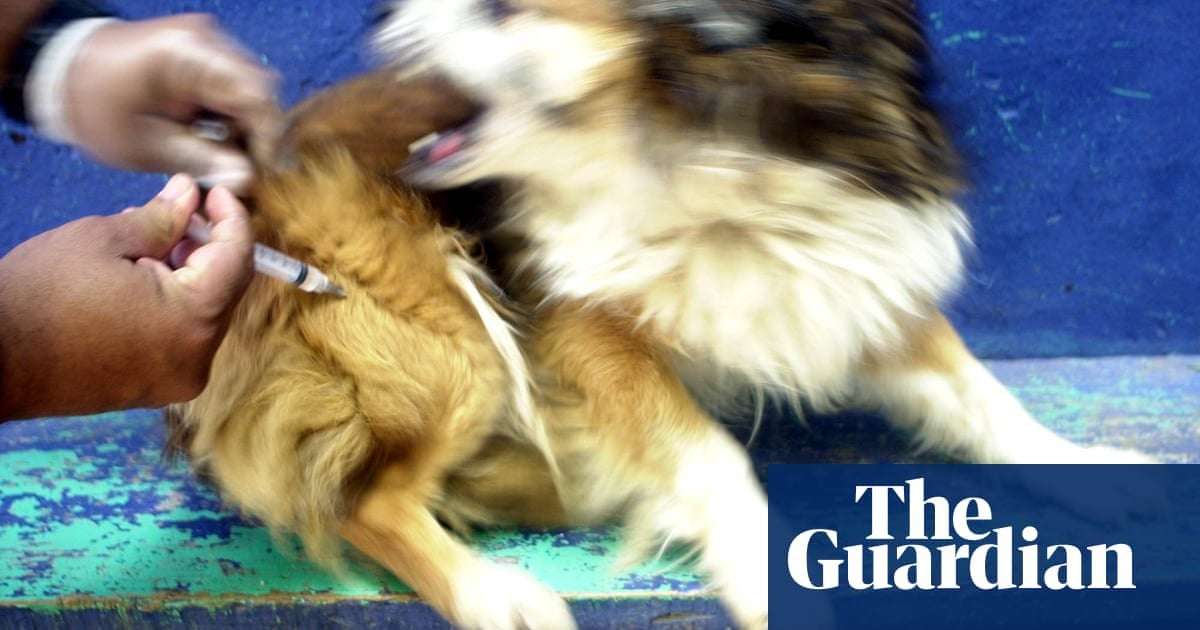New research raises hopes of oral vaccine for dogs, the chief source of transmission to humans
Researchers have discovered a way to stop rabies from shutting down critical responses in the immune system, a breakthrough that could pave the way for new tools to fight the deadly disease.
Rabies kills almost 60,000 people each year, mostly affecting poor and rural communities.
It is hoped that the discovery could lead to new and improved vaccines, including oral vaccines for dogs – which are responsible for the vast majority of transmissions to humans.
The study, published in Cell Reports and carried out by teams at Monash University and the University of Melbourne, provides crucial information about how the rabies virus targets the body.
The researchers believe they are the first to observe how a particular protein made by the rabies virus binds to a critical cellular protein known as Stat1, halting key parts of the immune response. The discovery has allowed scientists to make a modified, vulnerable version of the virus – which could be used to make a new, safe and effective live vaccine.
“You can very specifically change the rabies virus and change the sequences and structures of the proteins,” said Dr Greg Moseley, from the Monash Biomedicine Discovery Institute, a lead author of the study. “The modified virus can still reproduce, but is no longer able to stop strong antiviral immune mechanisms,” he added. “It is weakened and also should make a very strong immune response. Used in a vaccine, this would protect against infection by the deadly virus.”
Scientists plan to test these modifications in vaccine strains against rabies. If successful – and if regulatory hurdles are overcome – a modified vaccine could be administered orally to dogs through bait.
“If you can get high enough immunity in the dog population, rabies will die out. Safe and highly effective live oral vaccinations for dogs would make a great contribution to elimination,” said Moseley.
In up to 99% of cases, domestic dogs are responsible for transmitting the rabies virus to humans, according to the World Health Organization (WHO).
The disease is almost always fatal following the onset of clinical symptoms. Even if people manage to get medical treatment quickly, the cost of treating rabies exposure is often financially devastating for families.
Last year, the WHO announced a global strategy to eliminate dog-mediated rabies disease by 2030. Efforts by governments to tackle the disease have been hampered by a lack of funding and poor implementation.
Sarah Cleaveland, professor of comparative epidemiology at the University of Glasgow, said a new oral vaccine for dogs could provide a helpful additional tool in fighting rabies – especially in areas where injecting dogs is challenging.
Kenya moves to curb the rise of rabies – in pictures Read more
But she added that the vast majority of dogs in Africa and Asia are owned and can be restrained for vaccination, and that there are high quality injectable vaccines available. “These are not being applied effectively, largely due to a lack of resources and support to government veterinary services in low-income countries to deliver mass dog vaccination campaigns,” she said.
“We should not let the promise of new vaccines distract us from the urgent need for scaling up mass dog vaccination now,” she added.
The discovery by researchers at Monash University and the University of Melbourne not only offers hope in the battle against rabies, but could help tackle other diseases – such as the Nipah virus, related to the measles virus – that target the immune response in a similar way. The same tools that were used to study rabies could be used to tackle Nipah, paving the way for antiviral drugs or vaccines.

__BestOfReddit__ on November 18th, 2019 at 14:31 UTC »
Where do dogs pick up the infection from?
jeremysprinkle on November 18th, 2019 at 12:10 UTC »
“If you can get high enough immunity in the dog population, rabies will die out."
Until it's reintroduced by any of the following:
bats raccoons foxes jackals cats mongoosesGood luck vaccinating all of these wild species.
EDIT: Seems like this is much less of an issue than I expected.
mvea on November 18th, 2019 at 11:57 UTC »
The post title is a copy and paste from the first, third and eighth paragraphs of the linked popular press article here:
Journal Reference:
Structural Elucidation of Viral Antagonism of Innate Immunity at the STAT1 Interface
Hossain, Md. Alamgir et al.
Cell Reports, Volume 29, Issue 7, 1934 - 1945.e8
Link: https://www.cell.com/cell-reports/fulltext/S2211-1247(19)31320-8
DOI:https://doi.org/10.1016/j.celrep.2019.10.020
Highlights
• Elucidation of the interface of full-length STAT1 and a viral interferon antagonist
• The viral protein-STAT1 interface involves multiple distinct surfaces
• Ablation of the interaction requires multiple mutations at distinct sites
• Loss of viral protein-STAT1 interaction attenuates a rabies virus street strain
Summary
To evade immunity, many viruses express interferon antagonists that target STAT transcription factors as a major component of pathogenesis. Because of a lack of direct structural data, these interfaces are poorly understood. We report the structural analysis of full-length STAT1 binding to an interferon antagonist of a human pathogenic virus. The interface revealed by transferred cross-saturation NMR is complex, involving multiple regions in both the viral and cellular proteins. Molecular mapping analysis, combined with biophysical characterization and in vitro/in vivo functional assays, indicates that the interface is significant in disease caused by a pathogenic field-strain lyssavirus, with critical roles for contacts between the STAT1 coiled-coil/DNA-binding domains and specific regions within the viral protein. These data elucidate the potentially complex nature of IFN antagonist/STAT interactions, and the spatial relationship of protein interfaces that mediate immune evasion and replication, providing insight into how viruses can regulate these essential functions via single multifunctional proteins.
My take:
Very early days of basic research, but this is how discoveries start - by figuring out the fundamentals first.